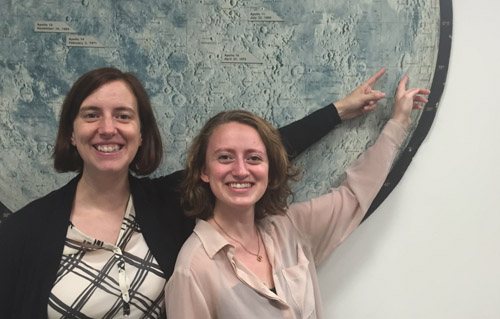
Annette Hilton Prospers from ‘Out-of-this World’ Research Experience

WOOSTER, Ohio — Undergraduate research opportunities routinely take College of Wooster students across the country and around the world, but Annette Hilton’s recent adventure lifted her to a new frontier — the far side of the Moon.
A junior geology major from Meadville, Pa., Hilton spent last summer in New York City at the American Museum of Natural History studying fragments from the lunar surface through a project funded by a National Science Foundation Research Experience for Undergraduates grant.
Working as an intern in the museum’s Department of Earth and Planetary Sciences, Hilton was paired with Juliane Gross, an associate at the museum and a member of the faculty at Rutgers University. Hilton and Gross spent 10 weeks studying a portion of what was believed to be a lunar meteorite that crashed in northwest Africa last year. “Dr. Gross studies lunar meteorites, and she was able to get a small portion of this meteorite loaned to the museum,” says Hilton. “Those who discovered it weren’t sure if it was from the Moon, so we were asked to conduct a geochemical analysis.”
Although the museum has access to state-of-the art equipment, it takes considerable time to conduct such an analysis, explains Hilton. “Our objective was to determine the chemical composition of the rock,” she says. “We could then use that data to determine what minerals were present, whether it came from the Moon, and if so, what type of rock it represented.”
What Hilton and Gross were looking for specifically was a certain ratio of iron (Fe) and manganese (Mn) in the rock. This ratio has been found to represent the physical conditions of the environment in which it forms, leaving a planetary fingerprint on the rocks. “Because of the samples brought back to Earth by astronauts on NASA’s Apollo missions, we now know what the Fe/Mn ratio is for the Moon, and can use it to identify meteorites,” says Hilton.
The fragments studied by Hilton and Gross, however, made their way to Earth’s surface in a different way — the result of an event on the lunar crust (most likely an asteroid hitting the Moon and loosening rocks that then broke away from the gravitational pull of the Moon). A small portion of those rocks survived the scorching heat of Earth’s atmosphere and fell harmlessly to the surface in Africa.
This particular rock weighed just 354 grams (less than one pound), and the museum received a very small (6×12 millimeter) sample, but it was enough to conduct a chemical analysis. What Hilton and Gross discovered was that the sample did, in fact, contain the proper ratio of iron and manganese, but this rock differed slightly from the ones brought back by the astronauts.
“We think that this sample may represent a different type of lunar rock that hasn’t been seen before because it had a very high magnesium content,” says Hilton. “Other analyses indicate that it may be from the far side of the Moon.” The Apollo missions landed on the nearside of the Moon, but the nearside and far side differ compositionally. The samples brought back by the Apollo missions have different compositions of magnesium and other elements.
“That may not seem like a big deal to the average person, but it is interesting to planetary scientists because they really don’t know much about the rest of the Moon’s surface,” adds Hilton. “And, because the Moon is no longer geologically active, these findings might tell us more about the ‘giant-impact hypothesis’ (the theory that Earth and Moon were formed at the same time), allowing us to gain a greater understanding of what the original material was that formed our planet.”
Hilton summarized her experience in an extensive research paper, which she wrote last fall. She also helped prepare an abstract that was submitted to the 47th Lunar and Planetary Sciences Conference, where she and Gross will present their findings in March. The classification Gross and Hilton made this summer has been officially accepted by the Meteoritical Bulletin, granting the meteorite a name: Northwest Africa 10401.
Having an opportunity to be part of an elite research team as an undergraduate has been quite a thrill for Hilton, and she credits Wooster, not only for helping her to land the internship, but also for its daily supportive learning community. “I absolutely would not be where I am now without the help of my brilliant professors in the geology department at Wooster,” she says. “To me, they are the biggest part of what makes Wooster great.”
Image: Annette Hilton (right), a junior geology major at The College of Wooster, and Juliane Gross, an associate at the American Museum of Natural History in New York City, conducted a geochemical analysis on a lunar meteorite this past summer during Hilton’s 10-week internship, which was made possible by a National Science Foundation Research Experience for Undergraduates grant.
Posted in News on January 11, 2016.
Related Posts
Related Areas of Study
Earth Sciences
Geology, environmental geoscience, geophysics, and other classes that explore Earth and the impact of humans
MinorGeology
Start research in your first year and graduate with a strong foundation in the Earth Sciences.
Major Minor

